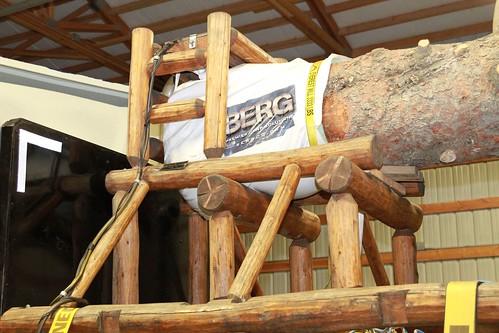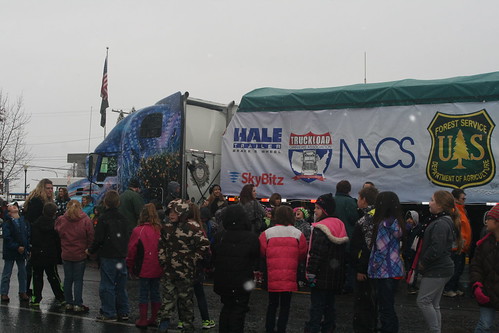
The 88-foot Engelmann spruce tree that will grace the west lawn of the U.S. Capitol as a gift from the people must first get from Colville National Forest in Washington State to Washington, D.C.
That means careful packing with special attention paid to cocooning the 2013 U.S. Capitol Christmas Tree so the thick branches stay intact and nothing hangs over the side of the trailer it is placed on.
“What does it take to wrap an 88-foot-tall Engelmann spruce?” said Franklin Pemberton of the Colville National Forest. “Also a lot of hard-working volunteers, 4,000 feet of parachute cord with a 550-pound breaking strength and a huge building.”
The tree wrapping process started at the harvest area on the Colville. Two large industrial cranes gently lowered the tree onto a custom-made cradle atop a special tractor trailer.
“The longest of the branches were tied up so they wouldn’t drag on the road for the trip from the harvest site to the Newport (Wash.) celebration and then to the wrapping site,” Pemberton said.
More than 20 volunteers worked in a large shop provided by Pend Oreille County in Washington State to help prep the tree for the journey.
“Once at the wrapping site, this is where the sticky, prickly and labor-intensive part of the process starts,” he said. “Volunteers start to move the branches towards the center of the tree, using ratcheting straps to move the larger branches into place near the trunk so that the tree will fit inside its protective box trailer.”

Once those branches are tucked as close as they will go to the trunk, volunteers tie the branches in place with the parachute cord. While doing this, the trees pitch, or sap, covers the volunteer’s hands, clothes and hair making for a sticky, but pleasant smelling ordeal.
Once tucked away, the tree is cocooned by aluminum frame and plywood siding. Hoops straddle the top to provide support and protection for a decorative tarp. The only exposed parts of the tree can be seen through three viewing windows. Two of the windows will let onlookers see the top of the tree decorated with lights and a few of the thousands of ornaments created by children in Washington State.
The third viewing area will give visitors a chance to see the 40-gallon bladder used to keep the thirsty tree moist and healthy along its trip.
The tree will stop in 22 cities on the way to the Capitol. The tree is expected to arrive at Andrews Air Force Base in Maryland on Nov. 24. On Nov. 25, the tree will be escorted into Washington, D.C. A tree lighting ceremony is scheduled for Dec. 3.
The tradition of a Christmas tree on the U.S. Capitol lawn began in 1964. The first several years live trees were planted but did not thrive. In 1970, the Capitol Architect asked the Forest Service for help.
Since then, a national forest is chosen each year, and residents of the state where the forest in located work together with partners throughout the state to take care of a variety of logistical needs. The community buildup starts roughly a year in advance as a grass-roots community effort to give the gift to all Americans, which is why it is dubbed “The People’s Tree.”
No tax dollars are used. However, Forest Service employees are assigned to help oversee the project.
Follow the tree’s journey.

